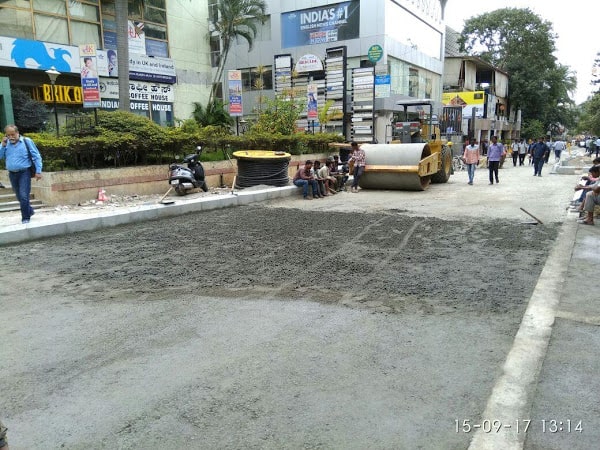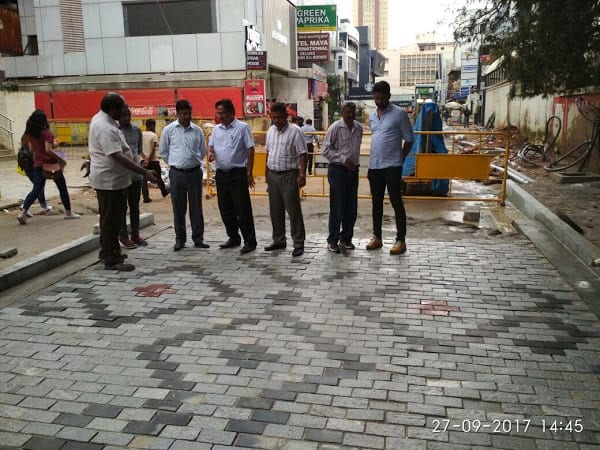Church Street is among the busiest streets in Bengaluru. It houses some of the most upscale business and entertainment establishments in the Central Business District (CBD). A few years ago, it was also synonymous with decaying infrastructure and chaos—crumbling footpaths, roads that would flood with the slightest shower, garbage. And these were just surface-level problems.
In 2015, the Bruhat Bengaluru Mahanagara Palike (BBMP) announced that the stretch would be redeveloped under the TenderSURE guidelines. The project was going to be financed through the Nagarothana Yojana by the Government of Karnataka at an estimated cost of about Rs 9 crores. However, the project took two years before it began on ground in February 2017.

Asphalting Church Street as part of redesigning it. Pic: BBMP
“The procedure to get the project going began with an excavation of the sub-base; topographical study for data collection; a traffic feasibility report; then a Detailed Project Report was tabled; costing was calculated and the tender was called for before project was approved. The sanctioning of the grant was the most time-consuming part, which is why it took so long to get started on the ground” says K.T. Nagaraj, Chief Engineer, Central Projects, BBMP.
While that remains the official line, one of the main challenges with the project was to get negotiate with multiple stakeholders including the owners of the business establishments given the expected disruptions to accessibility and utilities.
The two-year delay/ negotiation in getting the Church Street project going has presented a number of lessons for the Palike to deal with similar ventures for the future. At first glance, the numbers associated by the project hardly seem intimidating—revamping a 715 metre road shaped liked a trumpet going from 30 feet in width to 60 feet didn’t seem an infrastructure nightmare.
Lack of vision in modernising infrastructure
However, senior officials of BESCOM, BWSSB, BBMP, Bengaluru Traffic Police and the owners association met at least five times to hammer out the final details. “We had to understand the impact of what they had planned,” says Irfan Noor, Secretary, Church Street Occupants Association. It’s only then that everyone realised the magnitude of the project.
But the learning curve that came with the task has given the Palike invaluable lessons. In a way the project was indicative of the many of the problems that plague the older roads in the city (which will eventually have to be revamped). Before Bengaluru grew into BBMP, the Cantonment and Pete areas were peppered with narrow roads, some of which acted as service stretches for the main roads. They were usually dotted with single dwelling units and the utilities were planned accordingly. However with time, many of the streets turned into busy commercial hubs which meant their infrastructure became woefully inadequate. The same is true of Church Street as well.
“This case has been especially challenging. There is a high density unit every 30 feet, with power and sanitation requirements, which were originally planned for single bungalows. When we began digging the road, there were multiple lines of BESCOM and BWSSB to accommodate this demand.Then there was the fact that a lot of the establishments on MG Road also had their connections flowing into church street,” explains Naresh Narasimhan.
Discovery of a hidden stormwater drain
“At one place, we could hear water, but could not find where it came from. Finally at the junction of Rest House Road, Church Street and M G Road, we found a stormwater drain! Unfortunately we also saw that sewage was being released into it directly. It was quite a nightmare but it was not surprising. This will be true of every road in the city with legacy problem,” he adds.

Work in progress for laying cobbled stones. Pic: BBMP
The lack of coordination of the city service providers—BESCOM, BWSSB, BSNL and other private players became a very real issue.The government agencies have no detailed map of where their lines run through the city at a granular level and also have no coordination among themselves. So more often than not, Bengaluru roads are dug up multiple times and consecutively or repairs and upgrades, making life miserable for commuters and the general public at large.
“However that will not be the case for Church Street. We now have a map of the placement of utilities here so there is no confusion,” says Nagaraj. And then there was the traffic situation too. The road acts a de facto parking space if not a thoroughfare for motorists looking to get to M.G. Road.
“I think the first lesson that we learnt was how not to estimate time for a project like this” jokes Narasimhan. The project has already overshot the original deadline of six month and still is only half complete. Officials estimate it will need another couple of months before the stretch can become habitable for motorists and pedestrians alike. However this estimate was proposed before the October showers inundated the city. “The project was a gift that kept on giving. Every time we dug a section, there was a new challenge,” says Narasimhan.
Cobbled stones and no-flood zones
Church Street was also the first to have a cobbled stone on the road, as opposed to the plain asphalt with an even carriage way of 5.5 meters and pedestrian-friendly footpaths. The BESCOM transformers (except of one) which ate into the footpaths have been shifted inside the private properties on the stretch as the business owners also joined forces for the project.
“We expected our businesses to be hit when the project started and the loss has varied between 50 to 60%. But the whole point of it was to make the street better, so there was no point in half measures. It has indeed paid off as well. The flooding we saw in front of the metro station did not happen this time despite the torrential downpour” says Irfan Noor, Secretary, Church Street Occupants Association.

Cobbled stones laid on the street. Pic: BBMP
The utilities have been among the major challenge in the project. Though, Vijaya Bhaskar, the then-administrator at the BBMP had been quoted in the media as saying that none of the utilities would be shifted, the Palike finally went with all the guidelines listed under TenderSURE and allowed for upgrade through the years.
“The number of BESCOM HDP ducts for a road like Church Street is 4. We have put seven ducts of 200mm on each side of the road bringing that number at 14. There are 10 ducts of 100 mm for Optical Fiber Cables of OFC and for BWSSB we have used Electric resistance water pipes. We have also retained single house connections. There are drains on either sides of the roads for rainwater to flow into and utility trenches where these ducts run that keep them easily accessible,” says Nagaraj. “The basic idea is that nobody needs to cut this road for any kind of utility repair for the next 20 to 30 years,” says Narasimhan.
Making Church Street pedestrian-friendly
Another clear concept right at the start of the project was about imagining the character of the road. “Personally I would like to see this becoming a social hub of food and festivities, where the pedestrians are at the top of the hierarchy. There is a history to this street including an original sign post from the times of the Royal Mysore State in front of where the Empire Hotel currently stands.These pieces of our history should be preserved,” says Narasimhan. The establishment owners recently proposed to organise weekend carnivals on the stretch starting from December 1st till end of January to encourage non-motorised activities.
“There are certain aspects of this project which will be beneficial when we take up projects in around the CBD like Museum Road and Commercial Street. There will similarities where this experience will act as a time saving mechanism. We certainly will not be able to guess all the issues that lies below these road, given that they haven’t be upgraded in years, but this project certainly gave us yardstick on how to work around them” says Nagaraj.
If the government civic bodies properly execute the planning and continuously check out the work progress then surely we will see the drastic changes in Bengaluru infrastructure.
Great creating best practices setting an example to others yes it is true soon we could see amazing changes in Namma Bengaluru (but not drastic changes ….Drastic” means “severe” and generally has negative)
Hey,really nice article. Lots to learn. Making this to a youtube video will be very valuable .
Nice article, thanks for letting us know what is causing the long delays.